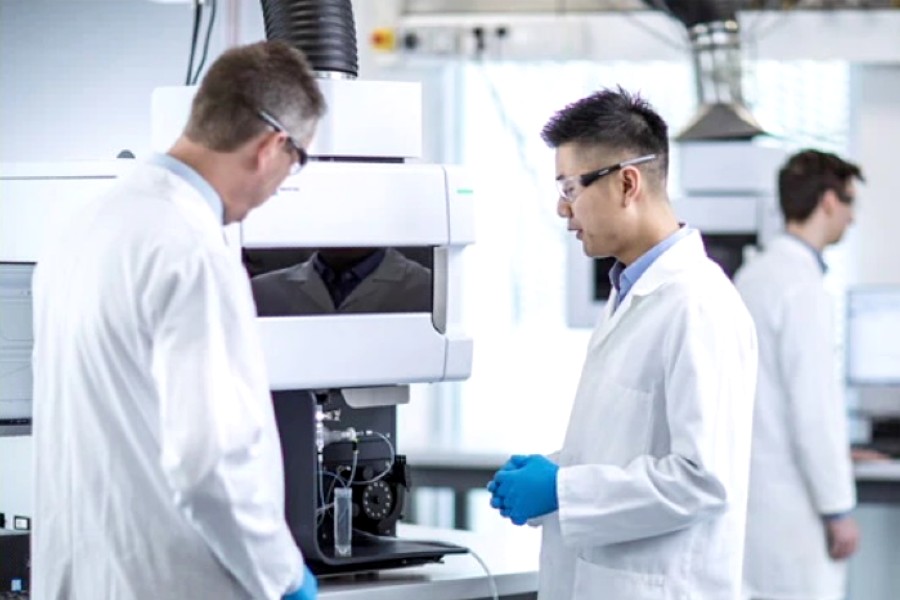
Imagine absorption spectroscopy as a powerful microscope that helps scientists examine the tiny building blocks of matter by watching how they react to different types of light.
It’s like having a special tool belt that scientists in chemistry, physics, astronomy, environmental science, and other cool areas use to understand the secrets of the universe on a super tiny level!
This article delves into the essentials of absorption spectroscopy. It sheds light on its principles, applications, and significance in understanding matter at a molecular and atomic level.
Understanding Absorption Spectroscopy
Absorption spectroscopy relies on the fundamental notion that distinct substances selectively absorb particular light wavelengths upon interacting with electromagnetic radiation. This absorption phenomenon is associated with shifts in energy states within the molecules or atoms. As electromagnetic radiation, such as light, traverses through a sample, specific wavelengths are absorbed by the sample while others penetrate through.
Imagine the absorbed wavelengths as stepping stones that electrons use to jump from a lower energy level to a higher one within the atoms or molecules of the sample. The pattern you see in the absorption spectrum is like a treasure map, giving you important clues about what the sample is made of, how its pieces are arranged, and how much of each substance is there.
Exploring Diverse Applications of Absorption Spectroscopy
Agilent absorption spectroscopy, as an example, stands as a versatile analytical technique with a multitude of applications, enabling scientists to unveil the mysteries of matter. Its precision in identifying and quantifying substances renders it an essential tool across various fields. Below are several notable applications of absorption spectroscopy:
1. Chemical Analysis and Quantification
Absorption spectroscopy helps scientists precisely figure out what substances are in a sample. This is super important, especially in making medicines, to make sure they’re pure and strong. It’s not just for labs, though—it’s also like an environmental superhero tool. Environmental scientists use it to find bad stuff in the air or water that makes sure the environment stays safe and healthy!
2. Biochemical Research
When scientists carefully observe how these molecules soak up light, it tells people important stuff about how these molecules are built, what they’re made of, and how they like to behave and do their job.
Comprehending their interactions with other molecules holds immense significance in drug development, personalized medicine, and the study of diseases. Absorption spectroscopy forms the cornerstone for investigating vital biochemical processes, laying the groundwork for advancements in healthcare and biotechnology.
3. Astronomy and Astrophysics
Astronomy and astrophysics harness the power of absorption spectroscopy to analyze the light emanating from celestial objects. By studying the absorption patterns in the spectra of stars, planets, and interstellar space, astronomers unravel the secrets of the cosmos. This analytical technique aids in determining the composition of celestial bodies, their physical conditions, and their evolutionary processes.
4. Material Science
Absorption spectroscopy holds a central role in the domain of material science. This empowers scientists to delve into the electronic and structural properties of various materials. Through the analysis of how materials absorb electromagnetic radiation, researchers can derive crucial insights into semiconductors, such as nanomaterials, polymers, and beyond.
This knowledge is of immense value in the design and engineering of advanced materials. It allows for the customization of properties to suit specific applications.
Significance and Future Directions
Absorption spectroscopy stands as a foundational analytical technique that constantly evolves in tandem with advancements in technology and methodology. Its crucial role lies in its capacity to reveal the intricate details of matter, enabling scientists to make well-informed decisions across diverse scientific domains.
As technology keeps getting better and cooler, absorption spectroscopy is going to become even more precise and sensitive. This upgrade will open up new, exciting roads for discovery, which will let you explore and understand the world in even greater detail.
- Exposure To THC In Breast Milk May Not Harm Infants Right Away, Study Finds
- Ballet Hispánico’s Quinceañera Gala Raises Over $1.3 Million For Arts And Community
- FTC Investigating TikTok Over Data Privacy Protocols From Harlem To Hollywood
- Sponsored Love: Unveiling SEO Success, The Power Of Paid Guest Post Services On Fiverr
- Black Public Media Awards For Film And Immersive Media Projects
Become a Harlem Insider!
By submitting this form, you are consenting to receive marketing emails from: Harlem World Magazine, 2521 1/2 west 42nd street, Los Angeles, CA, 90008, https://www.harlemworldmagazine.com. You can revoke your consent to receive emails at any time by using the SafeUnsubscribe® link, found at the bottom of every email. Emails are serviced by Constant Contact









